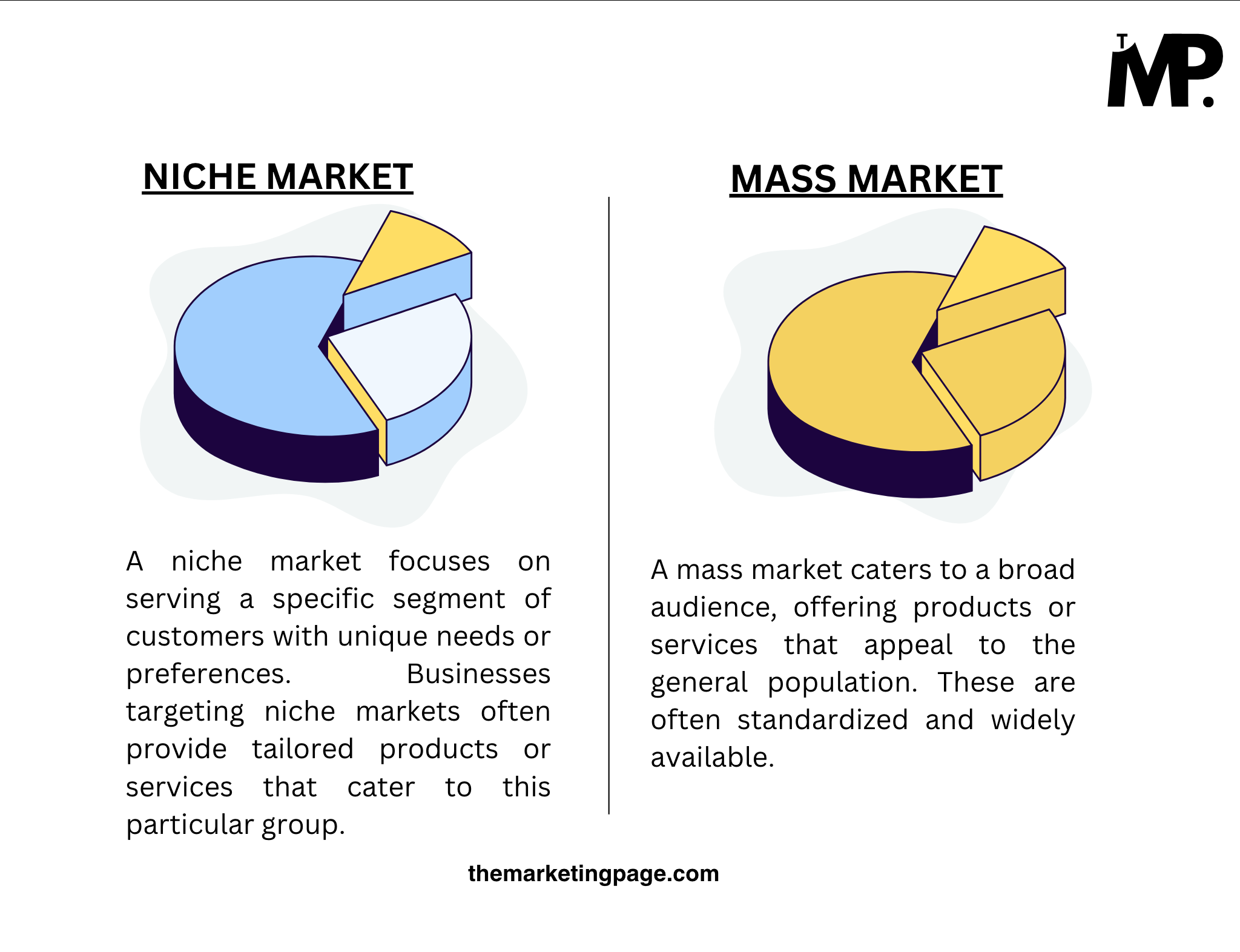Imagine you’re launching a new product.
Would you rather focus on a small group of loyal customers or aim to sell to everyone?
This is the key question when deciding between a niche market and a mass market strategy.
A niche market caters to a specific group with unique needs. Think vegan skincare or custom gaming PCs.
On the other hand, a mass market targets the general population. Think Coca-Cola or smartphones.
Each has its own strengths and challenges.
For students diving into marketing, understanding these two approaches is essential.
Why?
Because your market choice defines your strategy, success, and survival in business.
Let’s break them down!
What is a Niche Market?
A niche market focuses on serving a specific segment of customers with unique needs or preferences. Businesses targeting niche markets often provide tailored products or services that cater to this particular group.
Key features of a niche market
- Targets a smaller, defined group of people.
- Products or services are tailored to meet specialized demands.
- Strategies are highly personalized and directly address the niche audience.
- Often allows for higher pricing due to exclusivity and specialization.
- Businesses typically have deep knowledge about the niche audience.
Advantages of a niche market
- Fewer players competing for the same audience.
- Easier to build a strong, loyal customer base.
- Ability to charge premium prices.
- Establishes businesses as experts in their field.
- Marketing efforts resonate better with a well-defined audience.
Disadvantages of a niche market
- Small audience size may restrict scalability.
- Over-reliance on a specific audience or demand trend.
- Quickly saturated due to a smaller customer base.
- Tailoring products and services can be resource-intensive.
- Demand fluctuations can impact revenue streams.
Note: The term “resource-intensive” refers to activities, processes, or systems that require a significant amount of resources to function effectively. These resources can include Human resources (e.g., skilled labor, time, or effort), Financial resources (e.g., money or funding), Natural resources (e.g., energy, water, raw materials) or Technological resources (e.g., computing power, specialized tools). The term often has a negative connotation when efficiency or sustainability is a concern, but it may be acceptable or necessary in some contexts.
Examples of Niche Markets
Lush Cosmetics creates vegan, cruelty-free cosmetics that target eco-conscious consumers, requiring sustainable sourcing and ethical practices. In the fitness space, SilverSneakers specializes in equipment and programs designed for seniors, demanding thoughtful design and accessibility features.
What is a Mass Market?
A mass market caters to a broad audience, offering products or services that appeal to the general population. These are often standardized and widely available.
Key features of a mass market
- Targets a large and diverse group of people.
- Products are designed to meet common needs.
- High production volumes lower costs.
- Distribution and marketing cover multiple demographics.
- Focus on affordability to attract a wide customer base.
Advantages of a mass market
- Reaching a broad audience can generate significant income.
- Easy to expand into new regions or markets.
- Mass appeal helps establish widespread brand awareness.
- High-volume production reduces per-unit cost.
- Broader customer base reduces dependency on specific groups.
Disadvantages of a mass market
- Saturated market with many competitors.
- Limited ability to build deep customer loyalty.
- Expensive to advertise and reach such a wide audience.
- Profit margins may shrink due to price competition.
- Higher operational costs to manage large-scale production and distribution.
Examples of Mass Markets
- Fast food chains like McDonald’s.
- Smartphones by Apple or Samsung.
- Basic clothing brands like H&M.
- Household cleaning products like detergents.
- Streaming services like Netflix.
Difference Between Niche Market and Mass Market
Below is a detailed comparison between niche and mass markets:
| Feature | Niche Market | Mass Market |
|---|---|---|
| Audience Size | Small, specific audience | Large, broad audience |
| Product Customization | Highly tailored to unique needs | Standardized for general use |
| Competition | Low competition | High competition |
| Pricing Strategy | Premium pricing | Affordable pricing |
| Marketing Approach | Focused and personalized | Wide-reaching and generalized |
| Profit Margins | High due to specialization | Lower due to price competition |
| Growth Potential | Limited scalability | High scalability |
| Customer Loyalty | Strong, loyal customer base | Moderate loyalty |
| Production Costs | Higher due to customization | Lower due to economies of scale |
| Market Risk | High dependency on niche trends | Diversified risk due to broad appeal |
| Brand Positioning | Niche authority and expertise | Generalized brand recognition |
Conclusion
Deciding between a niche and mass market strategy depends on your goals, resources, and audience needs. Here’s a quick guide:
Go Niche if:
- You want to build deep customer loyalty.
- You solve specific pain points for a targeted audience.
- You can offer highly specialized products/services.
Go Mass Market if:
- You aim to scale quickly.
- You cater to broad, general needs.
- You have the resources to handle higher competition and larger campaigns.
Next Step:
- Conduct market research to identify gaps and opportunities in both markets.
- Test your UVP (Unique Value Proposition) through small campaigns.
- Choose the approach that aligns with your strengths and delivers lasting value.
Pro Tip: Start small, analyze results, and pivot as needed!

Leave a Comment